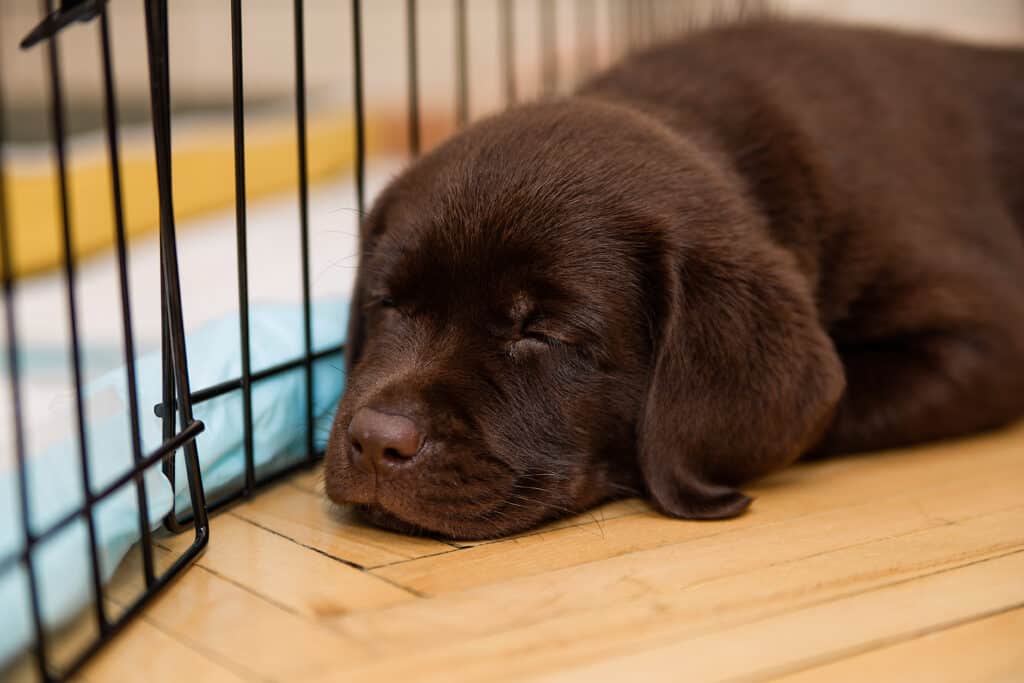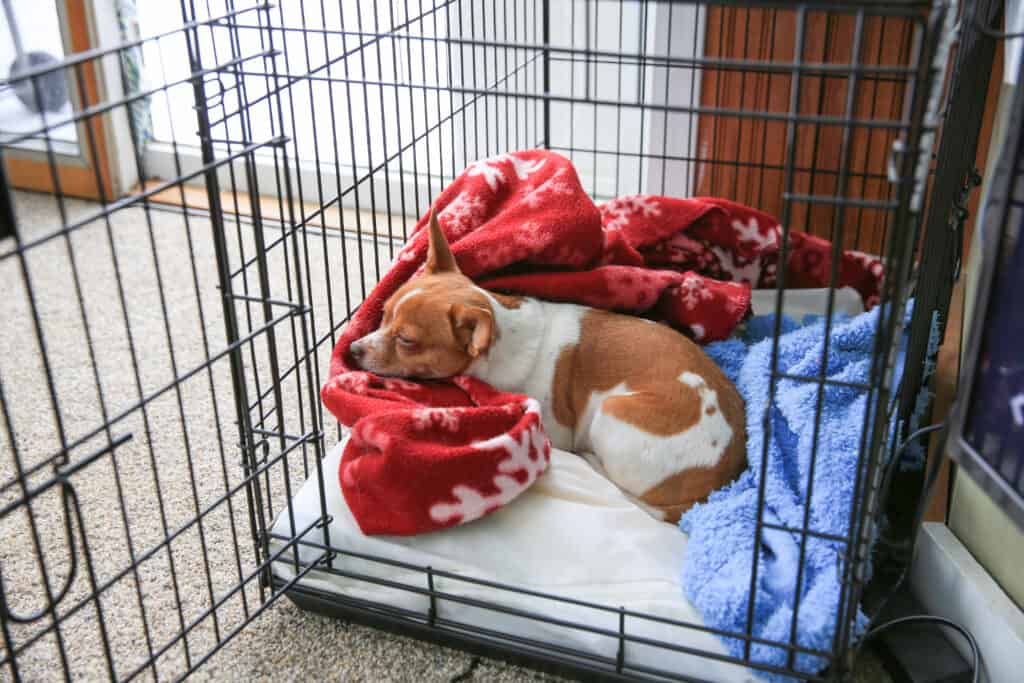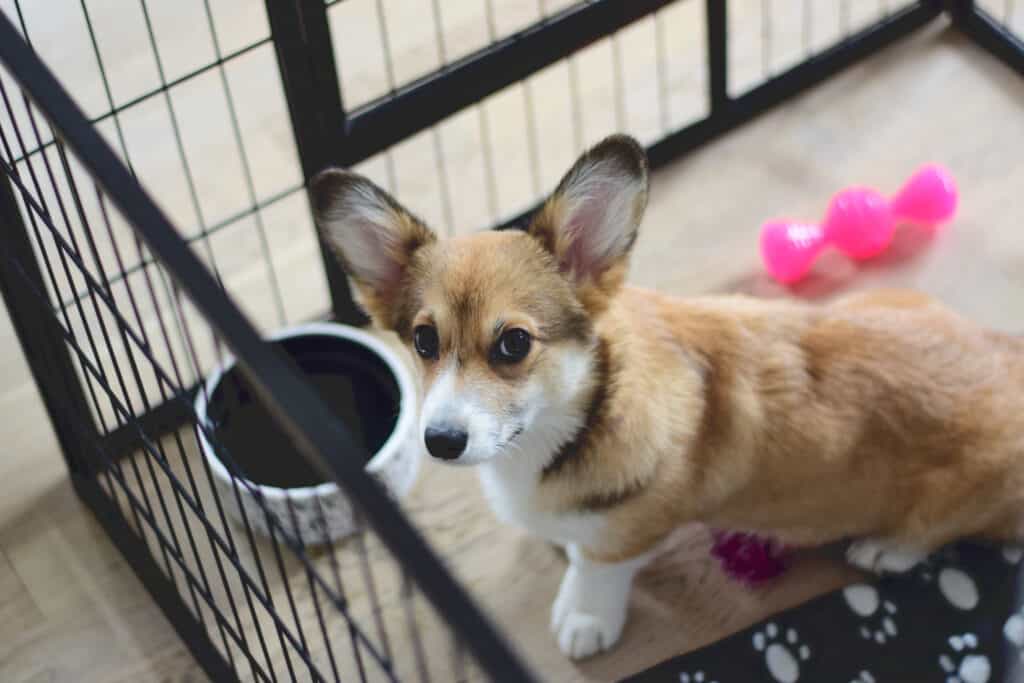Dogs are social animals, and they love to sleep in groups. That’s why many people bring their dogs into their beds.
It’s hard to tell whether a dog likes his crate or would rather sleep in the open. Some dogs bark or whine when left alone in a crate, but others settle down quickly and go to sleep.
If your dog is used to sleeping with you, it’s best to start crate training by leaving him in the crate for short periods to get used to being alone. Then, gradually, increase the time he spends in the crate until he’s comfortable staying there for extended periods.
If your dog doesn’t like being left alone, try leaving him with some toys or treats that will keep him occupied while you’re gone.
Other dogs enjoy sleeping on the floor, especially if other dogs or people are around them. That’s because they want to be close to people or other animals for protection or because it feels more comfortable than being enclosed in a crate.

Some dogs prefer sleeping in crates. Others prefer the floor.
©dikkenss/Shutterstock.com
Why Dogs Prefer Sleeping in Crates
Dogs tend to be very particular about how they sleep. For example, some dogs like to sleep in crates, while others don’t.
Some dogs are too anxious or fearful, and the confinement can worsen it. If your dog is afraid of small spaces or doesn’t like being confined, it’s best not to try using a crate for house training.
Here are some reasons why dogs prefer sleeping in crates:
It Protects Them
A crate is an effective way to keep your dog safe from harm in the event of a fire or other emergency. All pets must be removed from the danger zone as quickly as possible in an emergency and brought to safety outside the home.
You can place a crate near an exit door, so you can easily carry your pet out of the danger zone if there is any smoke or flames in the house. If there is no time to get outside, place your dog in his crate inside a closet where there will be less smoke or fumes from the burning materials around him. This will help protect him from inhaling harmful substances until he can be removed safely from the premises.
It Calms Them Down
Loud noises, such as fireworks or thunderstorms, can stress dogs. A crate provides a haven where dogs can retreat when they feel anxious or scared.
They have more control over their environment when in a crate than if they were left loose in the house. This can help reduce stress levels for dogs with separation anxiety who would otherwise have no escape from the chaos of family life.
It’s Cozy
Dogs love to be cozy. Their bodies are designed to keep them warm, so they often seek places that feel the best for them. That means curling up under blankets or on your lap for some dogs. For other dogs, it means snuggling up inside a crate that offers plenty of room to stretch out and get comfortable.
A crate provides a great place for dogs to curl up and get comfortable. It also helps them feel safe because they can feel hidden from view while sleeping inside their crate. Unfortunately, this isn’t always easy when your dog sleeps on your bed or couch.

A crate provides a great place for dogs to curl up and get comfortable. It can be a cozy place for them.
©Jennay Hitesman/Shutterstock.com
How to Choose a Perfect Dog Crate
Choosing a crate for your dog can be a daunting task. There are many different types and sizes to choose from, but what matters most is finding one that fits your dog’s needs.
Here are some things to consider when shopping for a crate for your dog.
Choose the Right Size Dog Crate
The size of the crate you choose will depend on the size of your dog. Dog owners with smaller dogs will need small crates, while those with larger dogs will need large crates.
A good rule of thumb is to choose a crate that allows your dog to stand up and turn around in his crate comfortably. This will ensure that he has enough room to move around and lie down without curling up in a ball or sitting in one place for extended periods.
The Sturdiness of the Crate
The sturdiness of the crate is vital. Your dog will be spending a lot of time in his crate, so it’s best if he feels safe and secure while he’s in there. If your dog isn’t comfortable in his cage, he might try to escape or chew through it.
Get one that’s made out of solid materials like steel or aluminum and doesn’t have any weak spots where your dog could break through or escape. Also, look for one with rubber feet on the bottom so it won’t scratch your floors or furniture if placed on top.
Multiple Entrances
A dog crate with multiple entrances is beneficial for several reasons. First, it allows you to place the crate in rooms where your dog will spend a lot of time. It also makes it easier for the dog to get in and out of the crate independently.
Most crates have one or two doors, but some have as many as four. Multiple entrances are convenient and safe, but they don’t provide security for your dog when in the crate, as he can escape through any door.
Ease of Cleaning
Crates are not meant to be left outside, so if you live in an area where the weather is warm or cold, you will need to clean them frequently.
Choose a crate made from plastic or metal that can be cleaned easily with soap and water or disinfected with a bleach solution. If you choose one made from cloth or canvas, make sure it is machine-washable so you can wash it often without having to send it out for professional cleaning services.
How to Crate-Train Your Dog
Crate training is one of the most effective ways to housebreak your dog. It’s also a great way to keep your dog safe while out of the house, especially if you have a destructive or anxious dog. Here are some simple steps for crate training your dog:
Introduce a Crate
The first step to making your dog comfortable with his crate is introducing it. Place the crate in a room with a lot of activity and let your dog explore it independently. Don’t force him into the crate; he should enter and exit as he pleases.
Feed Him in the Crate
Once he’s comfortable with being in the crate, start feeding him his dinner or breakfast kibble while he’s inside it. This will help reinforce the good things that happen when he’s inside the crate.
If your dog gets anxious at this stage, walk away and ignore him until he relaxes and finishes eating. Once he’s done, praise him and throw a treat inside the crate as you close it so he knows that good things happen when he enters it willingly.

Feeding your dog in the crate is a great method of crate training.
©Jus_Ol/Shutterstock.com
Crate the Dog at Night and When You’re Leaving
Crating your dog at night is essential to housebreaking because it prevents accidents from happening while you’re sleeping or away from home — especially when they are young puppies who haven’t yet mastered bladder control.
If possible, crating your dog when you leave for work or errands will make it easier for them to adjust to being alone during these times.
Why Do Some Dogs Like Sleeping in the Open?
Some dogs love to sleep in the open. They will sleep on the bed, sofa, or even in front of the fireplace.
There are several reasons why some dogs like sleeping in the open:
To Feel the Breeze
Dogs love feeling the breeze on their fur and bodies; it makes them feel more alert and alive. If you have a dog who likes sleeping outside, try leaving a window open when you go to bed at night (but ensure there’s a screen on it — you don’t want him getting out).
This will allow fresh air into your home while keeping your pup safely inside. You can also let him sleep under an umbrella if there’s rain forecasted or put up an outdoor tent for him if there’s too much sun exposure during certain times of the year.
For Comfort
Dogs sleep in the open because it’s comfortable. Like humans, dogs have a natural urge to sleep on something soft. Therefore, a dog that sleeps in the open finds a comfortable place to lie down and sleep, such as under a tree or a porch. This is especially true of dogs with long fur, who are more prone to itching if they sleep indoors.
Watching Over Their Territory
Dogs are territorial animals and like to keep an eye on their territory. Some dogs will even sleep in the open while guarding their territory. For example, if you have a dog who sleeps in the backyard, this could be because she is protecting her territory against other dogs and humans. She may even growl or bark at people close to your property line.
Bottom Line
Dogs aren’t picky regarding sleeping arrangements. They’ll be happy as long as they’re somewhere safe and warm. But, at the same time, there are likely some things we can take away.
First, just because a dog is okay with something doesn’t mean it should continue to do that thing repeatedly. If you’re in doubt about the sleeping arrangements of your pet, talk to a vet or go to a trainer so they can offer suggestions on how they believe your canine would be happier while sleeping. And finally, always know that all pets are different, like everyone.
The photo featured at the top of this post is © Stephanie Barnes/Shutterstock.com
Ready to discover the top 10 cutest dog breeds in the entire world?
How about the fastest dogs, the largest dogs and those that are -- quite frankly -- just the kindest dogs on the planet? Each day, AZ Animals sends out lists just like this to our thousands of email subscribers. And the best part? It's FREE. Join today by entering your email below.
Sources
- Not A Bully, Available here: https://notabully.org/why-does-my-dog-want-to-sleep-with-me-all-of-a-sudden/
- cdc, Available here: https://www.cdc.gov/healthypets/keeping-pets-and-people-healthy/emergencies.html
- Blue Cross, Available here: https://www.bluecross.org.uk/advice/dog/stress-in-dogs
Thank you for reading! Have some feedback for us? Contact the AZ Animals editorial team.






